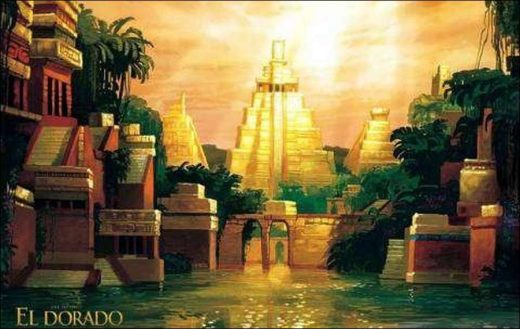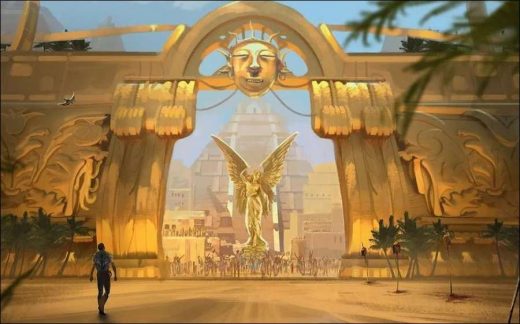Legend of the El Dorado. We will tell you about the lost El Dorado, a city of gold, a legend that has been spread from word to word since the 1500s. We have compiled for you the story of this legendary city, where hundreds of people died and thousands were lost in the rainforests of South America to find it.
Many people and explorers believe that El Dorado is located somewhere in the Andes Mountains in present-day Colombia. The inhabitants of the city are an indigenous tribe called Muiska. It is said that the Muiskan people were so rich that their king started the rituals by bathing in the sacred Lake Guatavita, wearing clothes made of gold dust. Then, the tribe makes offerings to their holy and evil gods in Lake Guatavita and returns to the cities they built of gold.
This is all we know about El Dorado, which has been searched for almost 500 years and has never been located. Of course, if we are talking about a legend that spread all over the world, then we can take a journey towards the origins of this story. Was El Dorado real? Or was it all just a legend?
We find the first traces of El Dorado in the memoirs of the Spaniard Hernan Cortes, who went to conquer the Aztec lands in 1541. Spanish explorers and conquerors who wanted to explore new worlds by setting out from Europe were fascinated, so to speak, when they encountered empires such as the Aztec and Inca. It is said that Cortes, who participated in many wars at the end of his adventures in the American continent, which they knew nothing about, talked about a city made entirely of gold.
This rumor truly fascinates the Spaniards who want to enrich themselves through shipping and exploration. Immediately preparing their ships and men, Gonzales Pizarro, Pedro de Cieza de Leon and many other Spaniards set their route to America. However, none of them could find this lost city of gold, and the story of the city of gold was not heard again until 1570.
When another Spanish explorer, Juan de Castellanos, completed his book “Elegías de Varones Ilustres de Indias” in 1570, in which he wrote about his heroism in America, it was time for the El Dorado legend to wake up.
According to the information in Juan de Castellanos’ book, there is a fertile valley in the east of the Andes, called Cundinamarca. The natives of this region, isolated from the outside world, are a tribe called Muisca. According to Castellanos, when he went to this valley, he witnessed a special ritual of the Muisca tribe. People gather on the edge of Guatavita, a giant crater lake, and watch their king sail into the lake in a boat after covering himself with gold dust. The king completes this sacred ceremony by throwing gold, emeralds and many other valuable items into the lake.
The name El Dorado, as we know it today, comes from the Spanish word “covered with gold”. According to some sources, El Dorado is the name of the lost city, while according to others, it is a name attributed to the Muisca King.
The El Dorado legend, which was searched by many explorers, especially the Spanish, German and French, until almost the mid-1800s, also caused many deaths. According to sources, at least 300 different explorers and their teams went to the rainforests in the shadow of the Andes Mountains in search of El Dorado.
An estimated 4,000 servants and thousands of animals who accompanied the explorers either died or were torn to pieces by the natives. Conclusion; The famous golden city is still lost, and more importantly, the idea that this city is cursed spreads from word to mouth. So what was the reason why a white city covered with gold turned into a cursed story? It is possible to get the answers from a current scientific research.
Nowadays, many people who take help from technology to solve the El Dorado mystery think that the lost city, where one of the world’s greatest treasures is hidden, may be in a different place. Some researchers and historians, who concentrate on the regions between Mexico and Brazil, focus specifically on Honduras. The reason is hidden in the geographical shape of the La Mosquitia region of Honduras. It is known that La Mosquitia, which has incredibly high and steep mountains and dense forests covering the mountains, has many valleys that have not yet been discovered scientifically.
Archaeologist Chris Fisher, a professor at Colorado State University, continues his research in the La Mosquitia region to solve the El Dorado legend and search for the lost city of gold. By mapping the geographical shape of the region using laser scanning from the sky, Fisher reaches incredible findings.
Discovering an area surrounded by four mounds in a square shape in a deep valley, the team prepares to go to the region. However, it is very difficult to even walk in the region where floods occur due to heavy rains, there are dangerous animals and there are no roads. The team searching for the mentioned mounds with a special helicopter and SAS Commandos who are experts in forests are lucky. The team found huge skull sculptures of animals such as jaguars and 52 specially carved chairs and containers, and deepened their research for 2 months.
As time progresses, the team searching for traces of the lost city of El Dorado in this region sees “Leishmaniasis” wounds, which is a very serious disease and resembles leprosy. Although there is no definitive cure for the disease caused by a parasite, the illness experienced by the team also supports the stories told about the terrible deaths of those who went to El Dorado. According to Fisher, the biggest reason why this region remains untouched may be Leishmaniasis, a disease caused by a parasite in the region that has lethal consequences.
As a result, we know that the lost city of El Dorado and its famous lost treasures have still not been found. According to some archaeologists and historians, El Dorado is a story too grandiose to be true; According to some, it may be so magnificent because it has not been found yet.
Visits: 69





